Harvest Hymn NCERT Solutions | English Poorvi Class 8 - New NCERT PDF Download
| Table of contents |

|
| Page No. 173 |

|
| Page No. 176-177 |

|
| Page No. 178-181 |

|
| Page No. 181-184 |

|
Page No. 173
Let us do these activities before we read
I. Work in pairs and share your responses with your classmates and teacher.
Q1: India celebrates many harvest festivals. When is the harvest festival celebrated in your region and how is it celebrated?
Ans:
Select harvest festival according to your region.
- Pongal: Pongal is celebrated in January. A four-day harvest festival primarily celebrated in Tamil Nadu.
- People celebrate this festival by offering prayers to the sun and cattle. Baisakhi: Baisakhi is celebrated in April. It is celebrated in Punjab and Haryana, it marks the new year in the Punjabi calendar and is a time for gratitude for the harvest.
- Bihu (Assam): A three-part harvest festival, with Rongali Bihu (Bohag Bihu) in April, Magh Bihu (Bhogali Bihu) in January, and Kongali Bihu (Kati Bihu) in October-November.
- Onam: Onam is celebrated in August- September. A ten-day harvest festival in Kerala, it celebrates the return of King Mahabali. They are cultural celebrations.People celebrate it by feasting.
- Navanna: Navanna (West Bengal) is celebrated during the Bengali month of Agrahayan, it marks the new rice harvest. People offer the first grains to Goddess Lakshmi.
- Vishu: Vishu (Kerala) is celebrated on the first day of the Malayalam month of Medam, it marks the beginning of the agricultural season. People celebrate it as the new year.
Q2: A hymn refers to a song of praise.
(i) To whom do we offer a hymn?
(ii) When and where do we sing a hymn?
(iii) Why do we offer it?
Ans:
(i) A hymn is usually offered to God or divine beings.
(ii) Hymns are sung during prayers, religious ceremonies, or festivals, often in temples, churches, or during community gatherings.
(iii) We offer hymns to express devotion, gratitude, and reverence to the divine for blessings and protection.
II. Some poets and authors use words that are no longer a part of common usage. Such words are called archaic words. Work in pairs. Read the sentences given below. Match the underlined archaic words in Column 1 with their meanings in Column 2.
Thou art my friend, and I trust thee. Thy kindness is great, and everything that is mine is thine.’
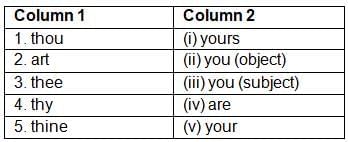 Ans:
Ans: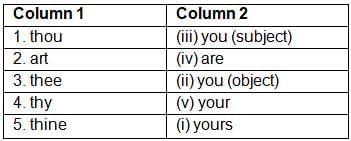
III. Work in pairs. Read the paragraph and select the correct meaning for each underlined word from the options given below. Share your answers with your classmates and teacher.
Under the golden 1. radiance of the evening sun, the villagers gathered to pay 2. tribute to their 3. cherished elder, who had dedicated his life to their well-being. His wise 4. counsel had guided generations, steering them through challenges. Known for his 5. munificent spirit, he never hesitated to share his resources generously.
1. radiance : (i) glow (ii) brilliance
2. tribute : (i) respect (ii) gratitude
3. cherished : (i) preserved (ii) loved
4. counsel : .(i) advice (ii) decision
5. munificent : (i) rich (ii) generous
Ans:
1. (ii),
2. (i),
3. (ii),
4. (i),
5. (ii)
Page No. 176-177
Let us discuss
I. Write the stanza number for the main idea of each stanza given below. Share your answers with your classmates and teacher.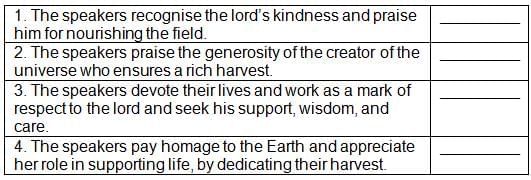
Ans:
1. Stanza 1
2. Stanza 4
3. Stanza 4
4. Stanza 3
II. Fill in the blanks by choosing the appropriate words or phrases from within the brackets.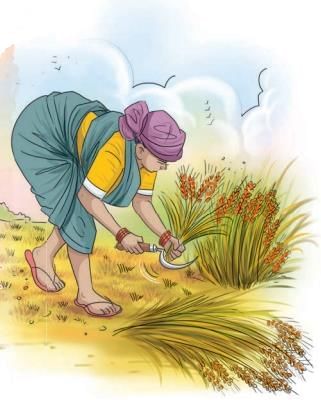 Q1: The setting of the poem is a rural landscape, possibly during a ____________ (harvest/religious) festival.
Q1: The setting of the poem is a rural landscape, possibly during a ____________ (harvest/religious) festival.
Q2: The tone of the poem is respectful and celebratory because it praises ____________ (the men and women / nature and the Lord) with deep respect and gratitude.
Q3: In the line Thou art our Hands and our Heart and our Home’, the letter ‘h’ is capitalised in ‘Hands’, ‘Heart’ and ‘Home’ because ____________ (it represents the hard work of farmers/ God resides in them)
Ans:
1. harvest
2. nature and the Lord
3. God resides in them.
III. Identify the poetic device used in the
- Bright and munificent lord of the morn!
- We bring thee our lives and our labours poetic device from
Ans:
- Alliteration
- Alliteration
IV. Match the lines from the poem in following lines from the poem. Column 1 with their expressions in Column 2. Choose the appropriate the box given below for tribute and write in Column 3.

Ans:
V. Certain words or phrases are repeated in the same line of the poem.
For example, The gold of our fields and the gold of our fruit;
Find more such repetitions from the poem. What is the poet’s purpose of using repetition in the poem?
Ans:
- We bring thee our songs and our garlands for tribute
- We praise thee… (repeated for different deities)
The poet uses repetition to create a rhythmic and musical quality, emphasize the importance of gratitude, and unify the voices of the community in praise.
VI. The poem uses symbolism to convey deeper meanings. Match the symbols in Column 1 with the meanings they convey in Column 2.
Ans:
Page No. 178-181
Let us think and reflect
I. Read the given extracts and answer the questions that follow.
Q1: We bring thee our songs and our garlands for tribute,
The gold of our fields and the gold of our fruit;
O giver of mellowing radiance, we hail thee,
We praise thee, O Surya, with cymbal and flute.
(i) What does the act of bringing songs and garlands as tribute suggest about the people’s relationship with the divine?
A. They fear the gods and wish to calm them in any way possible.
B. They have a deep sense of reverence and gratitude towards the divine.
C. They are forced to perform rituals without understanding the divine.
D. They depend on the gods for their daily needs and activities.
Ans: (B)
The act of bringing songs and garlands as tribute suggests that people have a deep sense of reverence and gratitude towards the divine.
(ii) Complete the following sentence suitably.
The word ‘gold’ in the phrases ‘the gold of our fields’ and ‘the gold of our fruit’ symbolises ____________
Ans: richness and abundance of the harvest
(iii) How does the description ‘O giver of mellowing radiance’ help us understand Surya’s role in the harvest?
Ans: It highlights Surya’s (Sun’s) role in ripening and nurturing the crops by providing gentle, life-giving light.
(iv) Fill in the blank by selecting the correct option from those given in the brackets.
The use of cymbal and flute signifies ____________ (joy and celebration/meditation and worship)
Ans: joy and celebration
Q2: All Voices:
Lord of the Universe, Lord of our being, Father eternal, ineffable Om!
Thou art the Seed and the Scythe of our harvests,
Thou art our Hands and our Heart and our Home.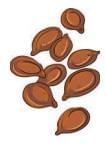
 (i) In the phrase ‘Lord of our being,’ what I does the word ‘being’ most likely refer to?
(i) In the phrase ‘Lord of our being,’ what I does the word ‘being’ most likely refer to?
A. Our physical body
B. Our entire existence
C. Our spiritual practices
D. Our earthly possessions
Ans: (B)
Our entire existence
(ii) Identify whether the following statement is true or false.
The imagery of ‘the Seed and the Scythe’ symbolises the divine’s role as both the beginning (creation) and the end (harvest) of the agricultural cycle.
Ans: True
(iii) Identify the phrases from the extract that mean the following:
A. The divine as a timeless, everlasting presence
B. Beyond human comprehension or description
Ans:
A. Father eternal
B. Ineffable Om
(iv) How do we know that these lines from the extract are spoken as a chorus?
Ans:
These lines from the extract are spoken as a chorus because the stanza is introduced with “All Voices”, indicating a collective, choral praise by the entire community.
II. Answer the following questions.
Q1: Why do the farmers hail the God of rain?
Ans: The farmers hail the God of rain because rain is essential for the crops to grow, and they are grateful to Varuna for nourishing the fields with rain and dew.
Q2: What is being referred to as “wealth of our valleys’? Why?
Ans: The phrase “wealth of our valleys’ refers to the freshly harvested crops, which represent the rich produce gathered from the valleys, symbolising prosperity and abundance.
Q3: State one reason why the women refer to the Earth as a ‘source of manifold gladness’.
Ans: The women refer to the Earth as a ‘source of manifold gladness’ because Mother Earth provides food, shelter, and life, bringing joy, sustenance, and well-being to all.
Q4: Why does everyone in the poem offer their “labours for tribute’?
Ans: Everyone in the poem offers their “labours for tribute’ to show gratitude to the divine for blessing their hard work with a successful harvest, and to dedicate their the celebration, unity, and richness of the efforts to the greater cosmic power. harvest season.
Q5: Why has the poet presented the poem as voices of men, women, and all voices?
Ans: The poet has presented the poem as voices of men, women, and all voices to show that the entire community — regardless of gender — comes together in unity and gratitude to celebrate the harvest and praise nature and divinity.
Q6: How does the poet create the joyous atmosphere of rural India at harvesting time?
Ans: The poet creates the joyous atmosphere of rural India at harvesting time by using vivid imagery, musical instruments (like cymbals, flutes, and drums), and words of praise and thanks, the poet conveys
Q7: Why is the poem presented as a hymn?
Ans: The poem is presented as a hymn because it is a song of praise and devotion, expressing spiritual gratitude towards nature and the divine for the blessings of the harvest.
Let us learn
I. Match the pictures of the farming implements given in Column 1 with their use given in Column 2. Then, fill in the blanks in Column 3 to complete the name of the implement.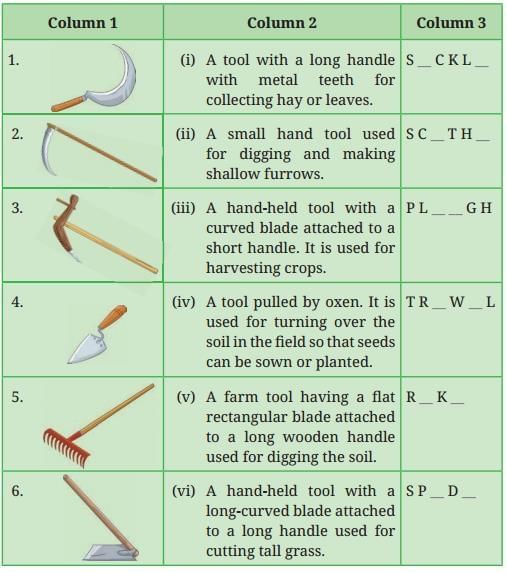 Ans:
Ans:
1. (iii) SICKLE
2. (vi) SCYTHE
3. (iv) PLOUGH
4. (ii) TROWEL
5. (i) RAKE
6. (v) SPADE
II Choose the correct synonyms for the underlined words in the given sentences from the box below. Circle the words or phrases in the sentences that helped you to infer the meanings. One example has been done for you. Q1: The king was benefient to the poor because he took good care of them.
Q1: The king was benefient to the poor because he took good care of them.
synonym: ______
Ans: kind
Q2: He was munificent towards the needy and donated a lot for their health care,
synonym: ____________
Ans: Generous
Q3: When he lost his job, all his friends gave him succour by supporting him with money.
synonym: ____________
Ans: Help
Q4: When the sun’s rays came into the dark room, the whole room was full of radiance,
synonym: ____________
Ans: Brightness
Q5: The little girl was speechless with ineffable joy when she got her birthday gift from her aunt.
synonym: ____________
Ans: Indescribable
III. You have learnt about some archaic words. Some more archaic words are given below. Refer to a dictionary to find commonly used words which are similar in meaning.
1. morrow
2. hither
3. quoth
4. betwixt
5. yonder
Ans:
1. tomorrow
2. here
3. said
4. between
5. over there
Page No. 181-184
Let us listen
I. Listen to the talk about paddy cultivation. As you listen, number the events in the correct order in which they happen.
(Transcript for teacher on page 203)
Hello everyone!
Did you know that rice is actually a type of grass, and the part we eat is its seed? Let me tell you about the process of cultivating rice.
It all starts with preparing the land. First, the soil has to be ploughed. Rice is typically grown in fertile soil that holds a lot of water. The most important step in preparing the soil is to soak it with plenty of water. This step is called puddling. Once the nursery bed is prepared, the seeds can be planted. After that, we sow the seeds on the soil’s surface.
Paddy farmers have to ensure that their filds stay floded with water because irrigation is crucial. It takes around 4 to 5 weeks for the seeds to grow into seedlings. After this comes the most important step—transplanting. The seedlings that were prepared in the nursery bed are uprooted and then transplanted into the floded fild.
In around 120 days, the rice plants are fully grown. At this point, the crops are harvested by cutting them. Following this, the seeds are separated from the plant. This is called threshing. To reduce the moisture content even more, the separated grains are dried. This ensures that they can be stored or processed further. Through a process called milling, the rice is separated from the outer covering on it.
Finally, the rice reaches the market, and that’s where we get it to make all kinds of delicious foods. Whether it’s Appam, Pulao, Khichdi, or Daal Bhaat, rice is a big part of many meals.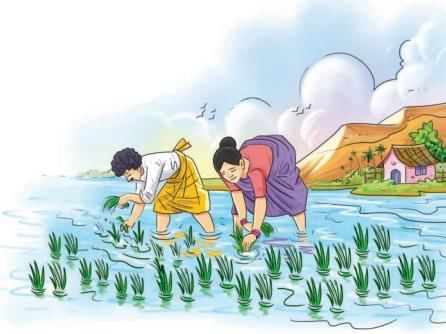 1. Transplanting of seedlings
1. Transplanting of seedlings
2. Ploughing of soil
3. Threshing of grains
4. Puddling of land
5. Harvesting of paddy
6. Irrigating the field
7. Milling of rice
Ans:
1. Ploughing of soil
2. Puddling of land
3. Irrigating the field
4. Transplanting of seedlings
5. Harvesting of paddy
6. Threshing of grains
7. Milling of rice
II. Now, listen to the talk again. As you listen, choose the correct option to answer the questions that follow.
Q1: What is the main step in preparing the soil for cultivation of rice?
(i) Ploughing the soil
(ii) Clearing the soil
(iii) Puddling the soil
Ans: (iii) Puddling the soil
Q2: How long does it take for rice seeds to grow into seedlings before being transplanted?
(i) 2-3 weeks
(ii) 4-5 weeks
(iii) 6-7 weeks
Ans: (ii) 4-5 weeks
Q3: Why is drying rice grains important after threshing?
(i) To get rice seeds for plantation
(ii) To separate the rice grains easily
(iii) To store the rice grains for longer
Ans: (iii) To store the rice grains for longer
Let us speak
I . In English, some letters are not pronounced in certain words. For example, in words like ‘knife’, ‘knowledge’, and ‘know’, the fist letter ‘k’ is not pronounced. Let us look at a few more such examples.
In the words given below the letter ‘n’ is silent when it appears with ‘m’ at the end of the word.
hymn, column, autumn, solemn
Now, say these words aloud.
In the words given below the letter ‘b’ is silent when it appears with ‘m’.
womb, tomb, bomb, climb, comb
Now, say these words aloud.
Ans:
Do it yourself.
II. In our country, harvest is celebrated with the preparation of delicious dishes. Work in groups and make a presentation on any popular dish made during the harvest festival in your region. Use the prompts given in the box to make your presentation. Make sure that all the members share their views.
Include the following:
- What is the dish called? Is it known by any other name in other parts of India?
- What ingredients are used to make the dish?
- How is the dish prepared?
- How is the dish served?
- What does the dish taste like?
- What is the special ritual related to the preparation of this dish? .
- Describe any special memory associated with the preparation of this dish.
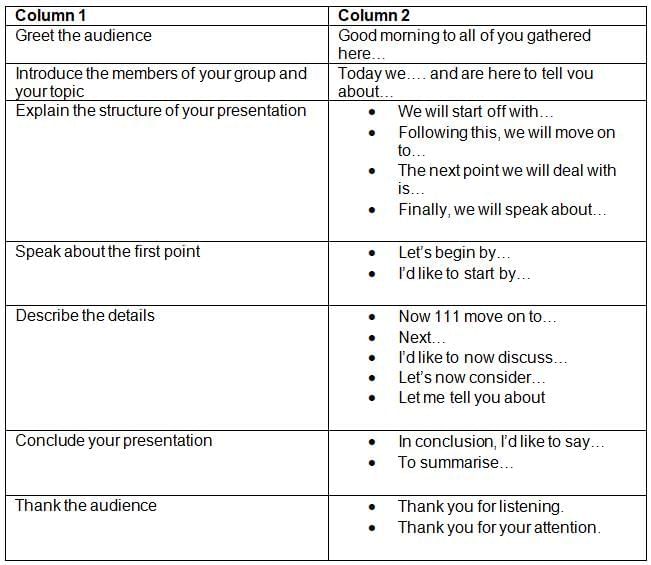
Ans:
Good morning respected Principal, teachers, and friends!
Today, we, Asha, Ravi, and I, are here to tell you about a delicious dish made during our harvest festival — Pongal also known as Ven Pongal in Tamil Nadu. It is made of rice, moong dal, ghee, pepper, cumin, ginger, and cashews. Rice and dal are boiled together, then tempered with spices in ghee. It is served usually hot, with chutney or sambhar on banana leaves. It tastes savoury, warm, and mildly spicy with a rich aroma. It is offered to the Sun God during Pongal festival. Every year, our grandmother makes it early in the morning and we eat it together as a family. Finally, I’d like to say that Pongal is not just a dish, it is a tradition that brings our family together. We hope you enjoyed learning about our harvest dish!
Thank you very much for listening to our presentation.
Let us write
Creative slogans are used to spread a message to capture the reader’s attention. Some examples are given below:
- Education is the Key, Unlock Your Destiny!
- Protect the Environment Today for a Better Tomorrow
- Learn, Grow, Succeed
- Go Green by Keeping the Planet Clean
Your school wishes to express gratitude to the farmers who play an important role in providing us the food on our plates. Draft a creative slogan to be put up on the school notice board.
Remember to
- focus on the main idea to be expressed
- use simple language
- be concise—express yourself in a few words
You may write the slogan on a chart paper and decorate it.
Ans:
No Farmers, No Food
Farmers Make Earth Smile
Let us explore
I. Millets are a varied group of small-seeded grasses. They have more fire and minerals than other cereals. Millets have been a part of the Indian cuisine for years. They have been rediscovered worldwide as superfoods.
Q1: Read the information on Pearl Millet given below.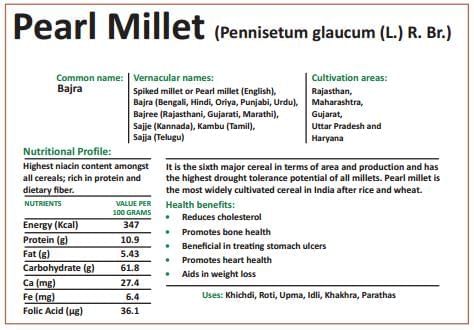
Use the link given below to know more about other kinds of millets.
https://eatrightindia.gov.in/millets2023/assets/documents/Millets -
Nutritious Cereal of India.pdf
Q2: Work in groups of four and do the following activities.
(i) Find out if millets are a part of your cuisine.
(ii) Find recipes with millets and compile them into a booklet.
(iii) Create a recipe of your choice.
Ans:
Do it yourself.
II. Songs related to harvest season form a part of our culture and heritage. Talk to the elders in your house and learn a song sung on a harvest festival. Share it with your classmates and teacher. Then, compile all the songs to create a songbook with the help of teacher.
Ans:
Do it yourself.
|
58 videos|435 docs|57 tests
|
FAQs on Harvest Hymn NCERT Solutions - English Poorvi Class 8 - New NCERT
| 1. What is the central theme of the poem "Harvest Hymn"? |  |
| 2. How does the poem "Harvest Hymn" depict the relationship between humans and nature? |  |
| 3. What literary devices are used in "Harvest Hymn" to enhance its meaning? |  |
| 4. Why is the harvest considered an important event in many cultures, as reflected in "Harvest Hymn"? |  |
| 5. How can "Harvest Hymn" be related to the concepts of sustainability and environmental awareness? |  |















